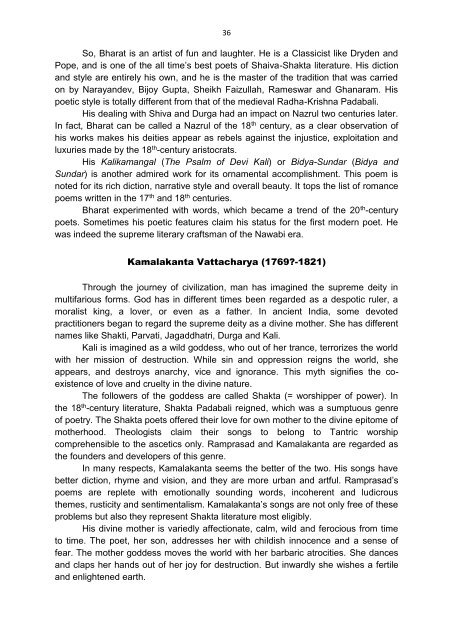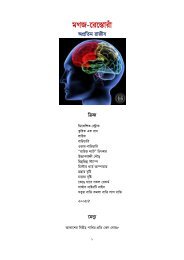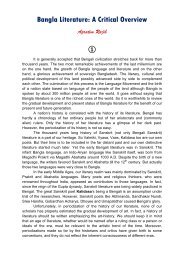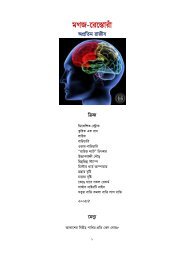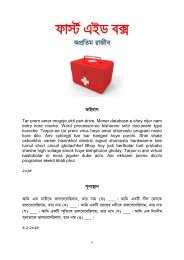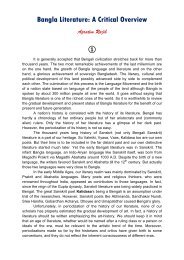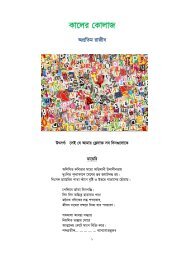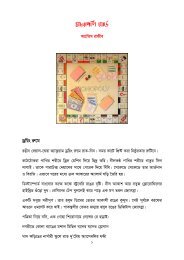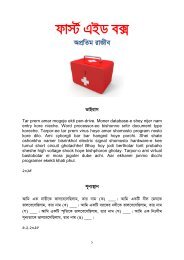BLiterature
Create successful ePaper yourself
Turn your PDF publications into a flip-book with our unique Google optimized e-Paper software.
36<br />
So, Bharat is an artist of fun and laughter. He is a Classicist like Dryden and<br />
Pope, and is one of the all time’s best poets of Shaiva-Shakta literature. His diction<br />
and style are entirely his own, and he is the master of the tradition that was carried<br />
on by Narayandev, Bijoy Gupta, Sheikh Faizullah, Rameswar and Ghanaram. His<br />
poetic style is totally different from that of the medieval Radha-Krishna Padabali.<br />
His dealing with Shiva and Durga had an impact on Nazrul two centuries later.<br />
In fact, Bharat can be called a Nazrul of the 18 th century, as a clear observation of<br />
his works makes his deities appear as rebels against the injustice, exploitation and<br />
luxuries made by the 18 th -century aristocrats.<br />
His Kalikamangal (The Psalm of Devi Kali) or Bidya-Sundar (Bidya and<br />
Sundar) is another admired work for its ornamental accomplishment. This poem is<br />
noted for its rich diction, narrative style and overall beauty. It tops the list of romance<br />
poems written in the 17 th and 18 th centuries.<br />
Bharat experimented with words, which became a trend of the 20 th -century<br />
poets. Sometimes his poetic features claim his status for the first modern poet. He<br />
was indeed the supreme literary craftsman of the Nawabi era.<br />
Kamalakanta Vattacharya (1769?-1821)<br />
Through the journey of civilization, man has imagined the supreme deity in<br />
multifarious forms. God has in different times been regarded as a despotic ruler, a<br />
moralist king, a lover, or even as a father. In ancient India, some devoted<br />
practitioners began to regard the supreme deity as a divine mother. She has different<br />
names like Shakti, Parvati, Jagaddhatri, Durga and Kali.<br />
Kali is imagined as a wild goddess, who out of her trance, terrorizes the world<br />
with her mission of destruction. While sin and oppression reigns the world, she<br />
appears, and destroys anarchy, vice and ignorance. This myth signifies the coexistence<br />
of love and cruelty in the divine nature.<br />
The followers of the goddess are called Shakta (= worshipper of power). In<br />
the 18 th -century literature, Shakta Padabali reigned, which was a sumptuous genre<br />
of poetry. The Shakta poets offered their love for own mother to the divine epitome of<br />
motherhood. Theologists claim their songs to belong to Tantric worship<br />
comprehensible to the ascetics only. Ramprasad and Kamalakanta are regarded as<br />
the founders and developers of this genre.<br />
In many respects, Kamalakanta seems the better of the two. His songs have<br />
better diction, rhyme and vision, and they are more urban and artful. Ramprasad’s<br />
poems are replete with emotionally sounding words, incoherent and ludicrous<br />
themes, rusticity and sentimentalism. Kamalakanta’s songs are not only free of these<br />
problems but also they represent Shakta literature most eligibly.<br />
His divine mother is variedly affectionate, calm, wild and ferocious from time<br />
to time. The poet, her son, addresses her with childish innocence and a sense of<br />
fear. The mother goddess moves the world with her barbaric atrocities. She dances<br />
and claps her hands out of her joy for destruction. But inwardly she wishes a fertile<br />
and enlightened earth.


